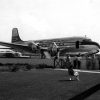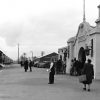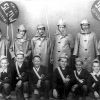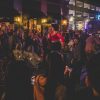The BigView
by Chris Murphy
There is really nothing like the sound of a hot rod motor, the squeal of tires and the sounds of the radio playing your favorite songs. Pulling in to a drive in, attended by a car hop on roller skates delivering a burger, fries and shake to you and your date, as you wait for your song dedication to be played on KFIV. This is the dream of Graffiti Summer and American Graffiti, immortalized in George Lucas’ milestone film about a night in Modesto USA that still rings true today in many ways.
As we celebrate Modesto 150th Anniversary and a virtual Graffiti Summer during this unusual year, we look at the decade that brought us rock and roll, bobby sox, and a date at the drive-in. The post war expansion paved the way for hot rods, chrome, and a certain innocence of youth in the mid-century. Stanislaus County celebrated its first centennial, Nixon visited, Save Mart was founded, and Modesto began to expand and the second high school would create the first cross-town rivalry, both in sports and cruising. We take you back to this time with two special featured by author, teacher and historian Ken White and author and historian Carl Beggese. Let’s go back in time.
Key resources:
www.modestocruiseroute.com
www.historicmodesto.com
modestogov.com/1967/History-of-Modesto
A Decade of Optimism, Growth, and Prosperity
By Ken White
Let’s rewind to a valley not so far away, not so long ago. To a nostalgic decade when the world was simpler, Ike was president, the music sweeter, and cruising was king. It was an innocent time in Modesto. Native-son George Lucas described it as a “Norman Rockwell” town. At least it seemed that way in the wake of the world war.
Downtown
Like the rest of the country, Modesto enjoyed unprecedented post-war optimism, growth, and prosperity.
For downtown Modesto, the Fifties were a decade of expansion. The population doubled and the town grew rapidly. Downtown was still the primary shopping area. However, for the first time, businesses began to leave the downtown core for suburban locations along J Street and McHenry Avenue, which until then had been mostly residential. In October 1953, McHenry Village Shopping Center opened. With 18 stores and services, it was the largest retail development until that time.
The Arts
For the Arts, the Fifties were an exceptional decade. Although Modesto was known primarily for its agricultural output, it was also home to a vibrant arts community. The Community Concert Association was founded in 1950, the Central California Art League in 1952. In October 1954, the 1,500 seat Mancini Music Bowl was dedicated with 3,000 citizens in attendance.
Community
For the community at large, the Fifties were an energetic decade.
In the early 1950s, a group of African-American families started the Monterey Park Tract community west of town. In October 1952, Richard M. Nixon made a second visit to Modesto to speak at Courthouse Park while running for vice president. In 1954, Stanislaus County celebrated its 100-year anniversary with a week-long celebration centered on the theme, “100 Years of Progress and Prosperity.” That same year, Modesto received its first All-America City Award.
Government
For Government, the Fifties were an exciting decade.
In 1951, a revised version of the 1949 city charter was ratified by the voters. It established a city manager form of government. In 1953, Modestan Ralph M. Brown, who represented the 30th Assembly District and was Speaker of the Assembly, authored the Brown Act, which provided increased public access to government meetings.
Entertainment, Recreation & Sports
For Entertainment, Recreation & Sports, the Fifties were an extraordinarydecade.
A news story of the time hinted at the active tradition of sports in Modesto. It read, “practically any type of sport you wish to take part in or witness may be found in Modesto and its surrounding territory.” Initiated by the Women’s Improvement Club, the city’s park system continued to expand. It was also during this time that the city built on its reputation as the “City of Trees.”
Planning for the city’s second golf facility, the Dryden Park Municipal Golf Course, was launched in 1954 when Horace and Dorothy Dryden donated 60 acres of land along the Tuolumne River. Along with Tom Moore and Tom Mellis, Fred Earle launched the Northern California Relays, later called the Modesto Relays, which began in 1942.
Community baseball dated back to Modesto’s beginnings. In the Fifties, the minor League Modesto Reds were a farm club for the Pittsburgh Pirates (1949-1952), Milwaukee Braves (1953), and New York Yankees (1954-1961).
The first private swim-tennis club, called the Modesto Racquet Club, was built by Fred Earle in 1957. Another private athletic club, the SOS (Sportsmen of Stanislaus) Club, also started in 1957.
A primary entertainment option in this decade remained AM radio. KTRB, KFIV, and KBEE were all broadcasting music, news, and sports.
Education
For education, it was an enlightening decade.
With the baby boom that followed the war, there was an urgent need for additional schools, resulting in the construction of twelve new schools in seven years. Modesto was a one-high-school town for 70 years. Downey High School opened in 1951 with 650 pupils. It was named after Thomas Downey, who was principal at both the old and new Modesto High.
Healthcare
For healthcare, the 1950s were an eventful decade.
More citizens spurred the growth of more healthcare facilities. In 1951, Memorial Hospital South opened in Ceres. The Stanislaus County Hospital and Almshouse, a stately Victorian structure erected in 1891, was torn down in 1950 to make room for the new Scenic General, a modern and efficient hospital.
Architecture
For architecture, the 1950s were an eclectic decade.
In the mid-twentieth century, Modesto became an architecture laboratory where both local and nationally known architects experimented with a new architectural style. They adapted European Modernism to the local climate and created Central Valley Modernism. Demolition of the historic Stanislaus County Courthouse, which had been built in 1872 and expanded in 1901, began in early 1958.
Business
In business, the decade of the Fifties was explosive.
In 1952, brothers-in-law Mike Piccinini and Nick Tocco opened their first Save Mart Supermarket in Modesto on Crows Landing Road. Construction of an expanded airport began in 1956. To accommodate the new generation of planes, it was necessary to acquire more acreage to construct a new 5,000 foot parallel runway and taxiway. In 1959, Jerry Marsh, who had built Modesto Bowl, teamed up with Art Sanders of Sanders Construction to build the twenty-four lane McHenry Bowl, which was an incredible two miles outside of town. The winery founded by Ernest and Julio Gallo continued to prosper and grow on their way to becoming the world’s largest.
The Graffiti Decade
The Fifties were the decade that established Modesto as the home of the car and cruising culture.
The Film
Throughout the ‘50s, “draggin’” 10th Street was the popular pastime for Modesto’s teenagers. This resulted in hometown hero George Lucas’ 1973 film American Graffiti that asked the question, “Where Were You in ‘62?” The film launched a world-wide resurgence of retro ’50s and ’60s culture, reintroducing the cars, the cruise, the customizers, the car clubs, the drive-ins, and the music to a world ready for small town authenticity.
The Cruise
The name “draggin’ Tenth” originated in Modesto as drivers would drag race from one traffic light to the next on Tenth Street. The original cruise route started at Burge’s Drive-in on Ninth Street, which was also Highway 99, and O Street, up to Tenth, a right, out Tenth, then a turnaround at the Modesto Fire Station block between F and G Streets, back down Tenth, a left on O, and back to Burge’s.
The Car Customizers
Modesto became home to some of the most legendary street rod builders and car customizers. The kings of the kustomizers included Gene Winfield, Marvin “Bart” Bartoni, and Pete Hischier.
The Car Clubs
Both the car guys and the motorcycle dudes formed clubs. Two of the first car clubs in Modesto were the 36’ers and the Century Toppers.
The Drive-Ins
In Modesto during the Fifties, drive-ins like Burge’s werewhere it was happening. Following the opening of Thomas Downey High School in 1951, Downey students adopted Al’s and Felix’s Drive-ins on McHenry.
The Music
Music had always been a big part of Modesto history. The Maddox Brothers and Rose helped forge the rockabilly style that paved the way for the rock ‘n’ roll bands that followed. Early local rock bands like Kent Whitt & the Downbeats with Roddy Jackson and Jim Burgett played at the California Ballroom, Playland and others.
As the teenagers dragged Tenth, KFIV-1360 AM would play the popular songs of the day. Boys and girls purchased the records they heard on the radio at Harley’s Records, located at 1218 J Street. North and across the street, there was another store simply called “Records” at 14th and J.
End of the Decade
With the close of the Fifties and the dawning of the Sixties, Modesto waved goodbye to innocence and smiled hello to turbulence.
(Do-do-do-do-do)
Goodnight, sweetheart, well it’s time to go,
(Ba-do ba-do)
I hate to leave you, but I really must say,
Goodnight, sweetheart, goodnight.
A Quick Trip Through a Baby Boomer’s Childhood
By Carl Baggese
Without stating the obvious, I was born in the early, first wave of what would become the Baby Boomer generation. As a result, my childhood was spent almost entirely in the 1950s – in person, in other words, I was there during the decade that we who lived through it recall as mostly a time of calm. We were too young to concern ourselves with Joseph McCarthy or the Cold War, although there was always that threat of nuclear annihilation hanging over us – we all learned to duck and cover in school.
Living in a small, rural community probably felt more secure than being raised in bigger cities in California. Modesto’s population was around 15,000 at the beginning of the decade. It wasn’t until the 1960s that the town had a growth spurt. Not only did I live in a rural community, but my home was in an even more rural part of town at the corner of Coffee Road and Norwegian Avenue. We lived in an old five-room farmhouse on four and a half acres. When I started school, it was at Bel Passi School, which was on Sylvan Road (where the Sylvan District Office now sits). Sometime that kindergarten year, we were moved to the new Sylvan Elementary School on Coffee Road, with its modern classrooms and tile floors, and out of the single room kindergarten class. Because there were so many kids, schools were forced into double sessions and old military style Quonset huts were brought in to double as classrooms.
My grandmother, aunts and cousins lived on the other side of Modesto at 525 5th Street. It was a long trip from our house to the 1920s arts and crafts style bungalow that my mother’s family lived in. We made the trip frequently down bumpy, pot-holed two-lane Coffee Road in our 1948 Chevy. The area around 5th Street was all residential with quaint homes built in the 1920s. Until the state bought the homes across the street for the highway 99 freeway, the neighborhood was filled with middle class families who worked in Modesto’s various businesses.
Fourth Street Park was just a block away, and it had the neatest feature for a kid – a recessed area that featured raised concrete ponds with goldfish and plants, and hillsides going up to street level. You could have a fun time getting dizzy rolling down the slopes. The swings were great, too – not the safe kind in today’s playgrounds – we had real swings with no limitations as to how high you could go.
We would walk a few blocks to H Street and stop at Bluett’s Ice Cream Parlor where we’d feast on Velvet Ice Cream. Within a few blocks down H was Modesto High School and the shops around it included an Casazza’s Italian Delicatessen (best raviolis in town), Safeway Supermarket (later Lee Sang Market) and the Rexall Drug Store on the corner of 4th Street and H (where my aunt worked and I could replenish my comic book collection).



















